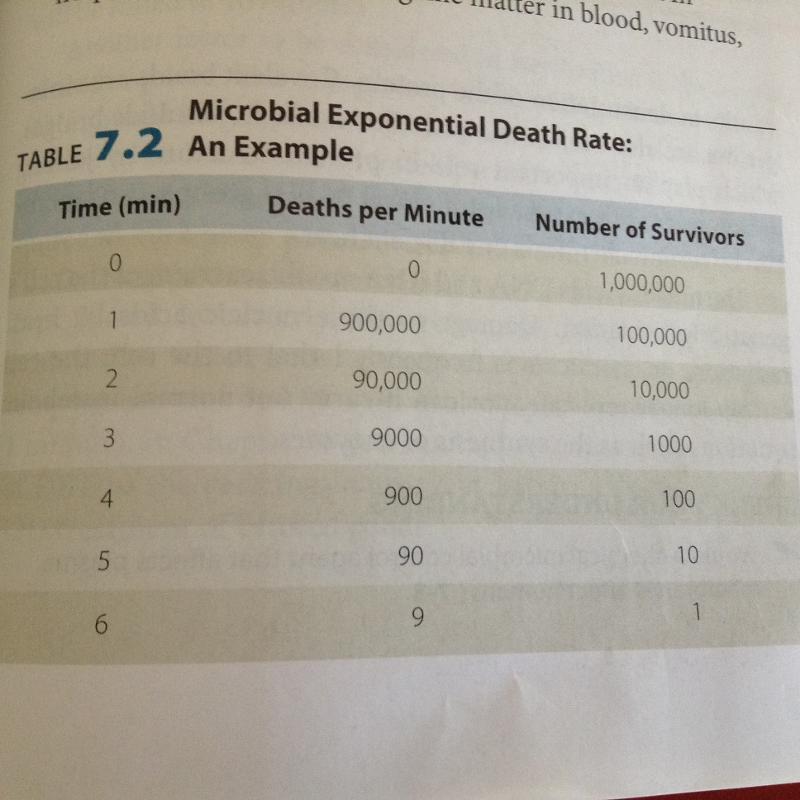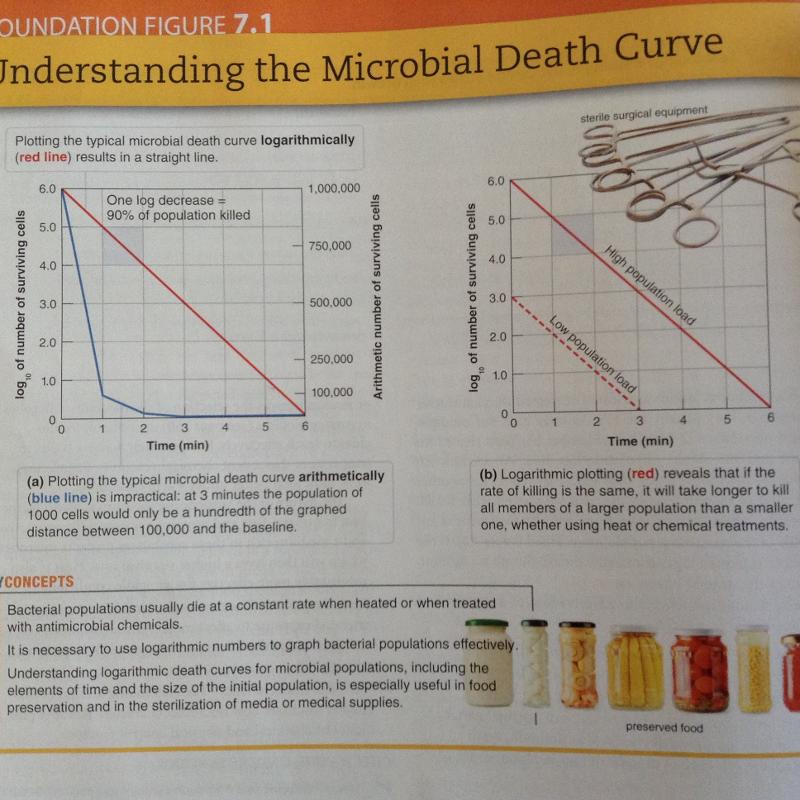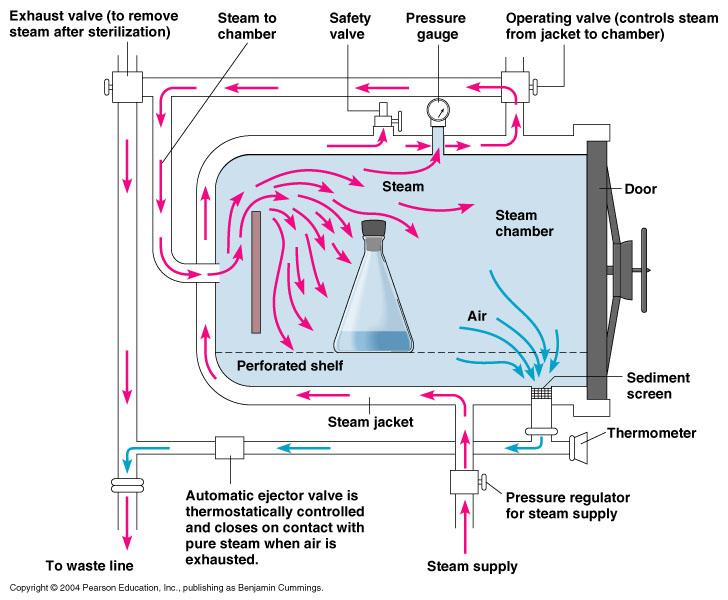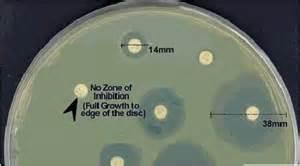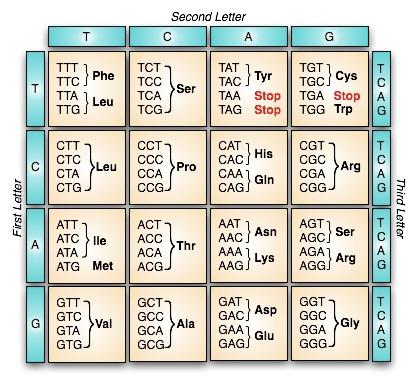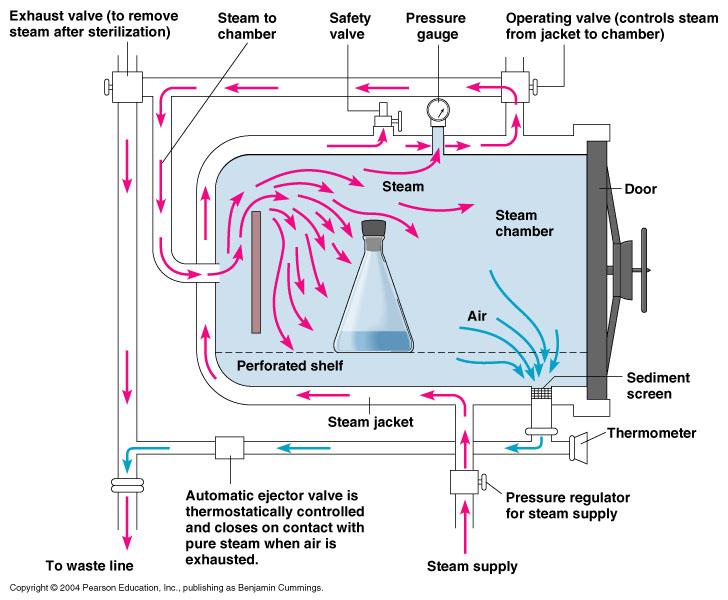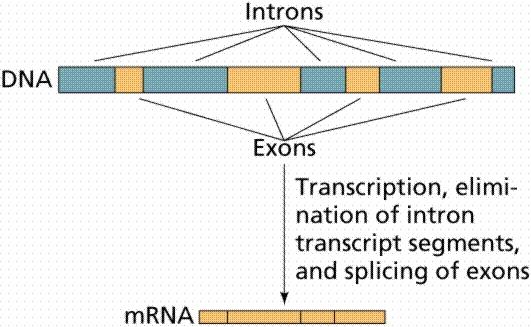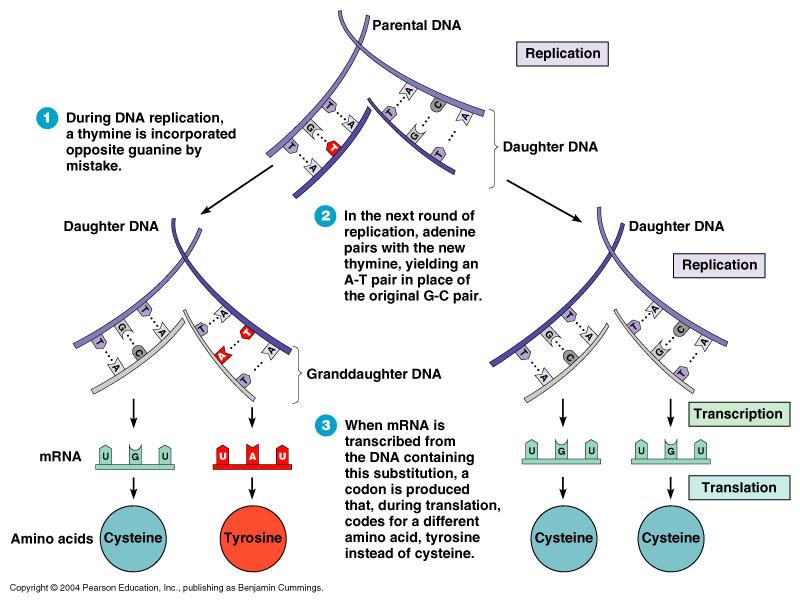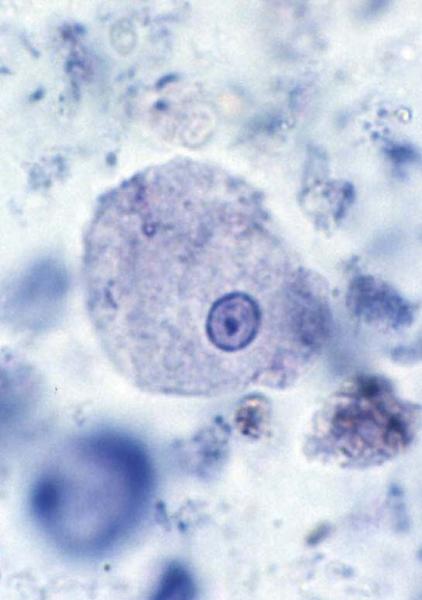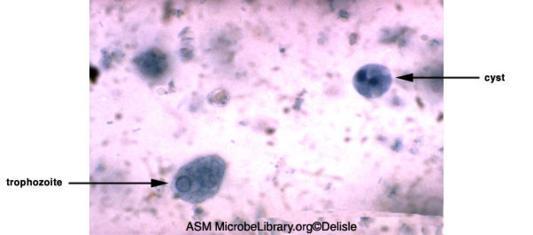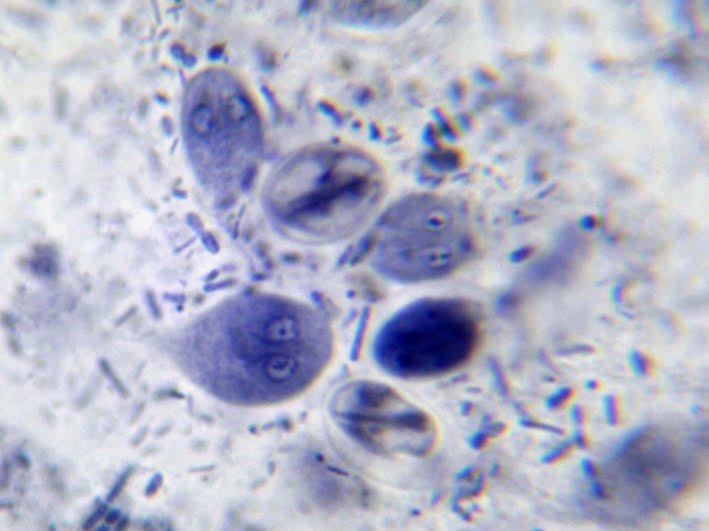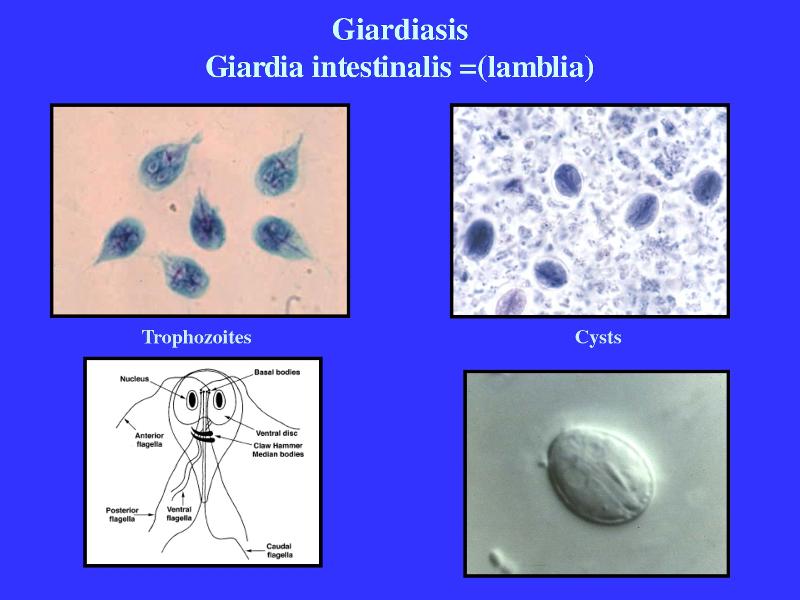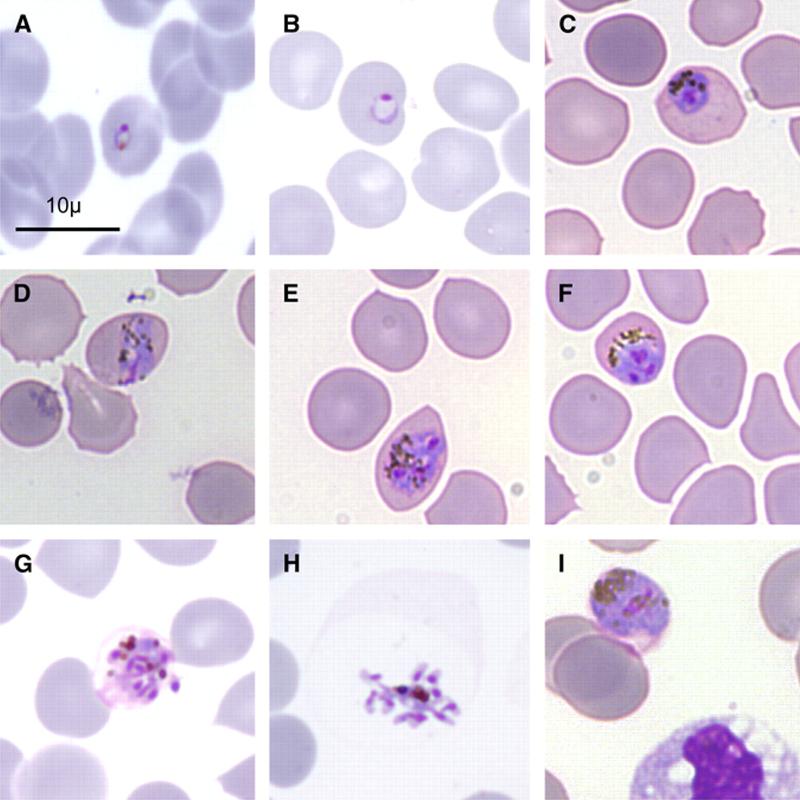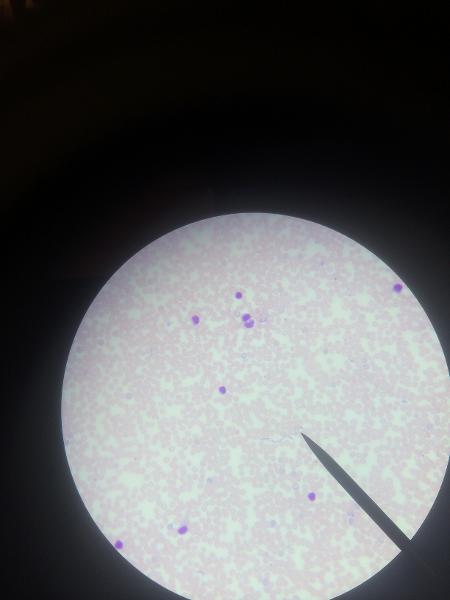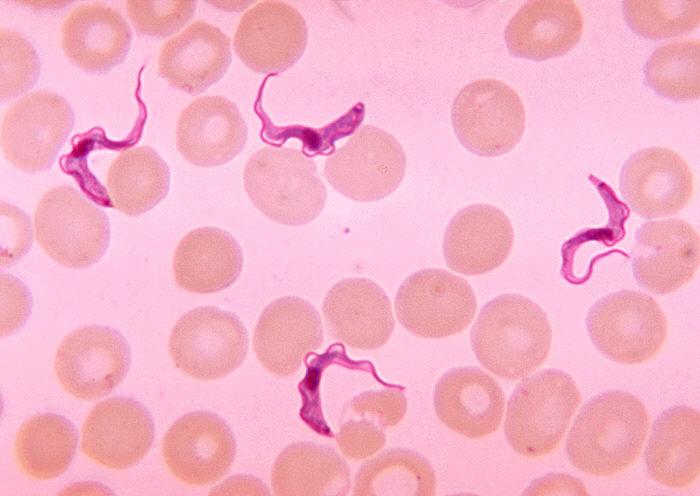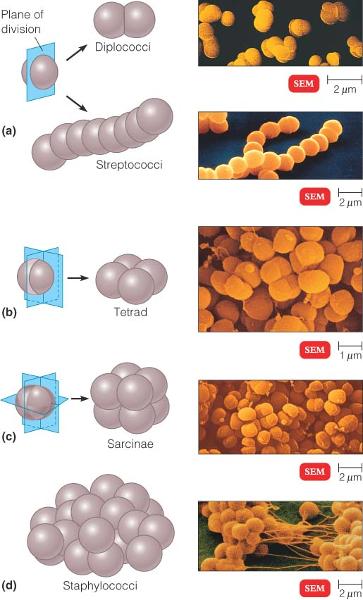| back 1 - Destruction or removal of all forms of microbial life,
including endospores but with the possible exception of prions
- (usually done by steam under pressure or a sterilizing gas such
as ethylene oxide)
|
| back 2 - destruction of vegetative pathogens
- ( may make use of
physical or chemical methods)
|
| back 3 - treatment is intended to lower microbial counts on eating and
drinking utensils to safe public health levels
- (may be done
with high-temperature washing or by dipping into a chemical
disinfectant)
|
| back 4 - removal of microbes from a limited area, such as the skin
around an injection site
- (mostly a mechanical removal by an
alcohol-soaked swab)
|
| back 5 - destruction of vegetative pathogens on living tissue
- (treatment is almost always by chemical antibacterials)
|
front 6 define:
commercial sterilization | back 6 - sufficient heat treatment to kill endospores of Clostridium
botulinum in canned food
- (more-resistant endospores of
thermophilic bacteria may surevive, but they will not germinate and
grow under normal conditions)
|
front 7 What factors influence the effectiveness of antimicrobial treatments? | back 7 -
the # of
microbes: more microbes = longer to eliminate entire
population
-
environmental
influences: presence of organic matter (ex.
blood, vomit, feces) often inhibits antimicrobial and influences the
selection of disinfectants.
-
time of
exposure
-
microbial
characteristics
|
front 8 Why do we express bacterial death rate logarithmically? | back 8 - Bacterial populations usually die at a constant rate when
heated or when treated with antimicrobial chemicals.
- EX: a
population of 1 million microbes treated for 1 minute, 90% of the
poplation die, now we're left with 100,000 microbes
|
front 9 understand concepts in regards to the microbial death curve | |
front 10 In what ways do control treatments act on microbes? | back 10 -
Alteration of membrane permeability: damage to the
lipids or proteins of the plasma membrane by antimicrobial agents
causes cellular contents to leak into the surrounding medium and
interferes with the growth of the cell
-
Damage to proteins & nucleic acids:
denaturation of proteins by heat or certain chemicals by
breaking/attacking chemical (H) bonds of amino acids that give
protein its shape; damage to nucleic acids (DNA&RNA) by heat,
radiation, or chemicals=lethal to cell--->can not replicate,
carry out normal metabolic functions
|
front 11 Thermal death point (TDP) | back 11 -
the lowest temperature at
which all the microorganisms in a particular liquid
suspension will be
killed in 10 minutes
|
| back 12 - the minimal length of time for all bacteria in a particular
liquid culture to be killed at a given temperature
|
front 13 Decimal reduction time (DRT or D Value) | back 13 - DRT is the time in minutes in which 90% of a population of
bacteria at a given temperature will be killed
|
front 14
Moist heat in the means of controlling microbial growth | back 14 - moist heat kills microorganism by coagulating proteins
(denaturation) which is caused by breakage of the hydrgen
bond that hold the proteins in their 3D shape
- types of
moist heat sterilization boiling(not very reliable), autoclave (more
reliable)
- sterilizing the surface of a solid requires that
steam actually come in contact with it
|
| back 15 - MOA: protein denaturation
- kills vegetative bacterial
& fungal pathogens and some viruses within 10 min, less
effective on endospores & other viruses ( some viruses can
survive up to 30+ minutes of boiling; some endospores can resist
boiling for 20+ hrs )
- uses: dishes, basin, pitchers,
various equipment
|
| back 16 - MOA: protein denaturation
- Very effect method of
steriliztion; @ about 15 psi of pressure (121 C), all vegative cells
and their endospores are killed in 15 min
- disadvantage:
steam under pressure fails to sterilize when the air is not
completely exhausted
- uses: microbiological media,
solutions, linens, utensils, dressings, equipment
|
front 17
dry heat as a means of controlling microbial growth | back 17 - kills by oxidation effects
- methods include: direct
flaming, incineration & hot-air sterilization
- takes
longer & requires higher temperatures (vs moist heat)
|
| back 18 - MOA: burning contaminats to ashes
- very effective
method of sterilization
- uses: inoculating
loops--->effectively>heat the wire to a red glow
|
| back 19 - MOA: burning to ashes
- very effective method of
sterilization
- uses: paper cups, contaminated dressings,
animal carcasses, bags, wipes
|
| back 20 - MOA: oxidation
- very effected method of sterilization
but requires temp of 170 C for about 2 hr
- uses: empty
glassware, instruments, needles , glass syringes
|
front 21
pasteurization as a means for control of microbial growth | back 21 -
mild heating to food
products, that sufficiently kills microbes that cause
spoilage and pathogenic
microbes without changing the taste of the product too
much.
- MOA: protein denaturation
- lowers microbial
numbers
- many thermoduric bacteria survive pasteurization but
they are unlikely to cause disease
-
high temperature short-time (HTST) pasteurization:
common pasteurizing method; temp typically 72 C for 15 sec; applied
as milk continuously passes a heat exchange; lowers total bacterial
counts
-
ultra high temperature (UHT) treatments: means of
commercial sterilization of milk
|
| back 22 - MOA: separation of bacteria from suspending liquid
- removes microbes by passage of liquid or gas through a screen
like material; most filters in use consist of cellulose acetate or
nitrocellulose
- Uses: sterilizing liquids (enzymes, vaccines)
that are destroyed by heat
|
| back 23 - MOA: plasmolysis
- results in loss of water from
microbial cells
- uses: food preservation
|
| back 24 - gamma rays have a short wavelength (less than 1 nm) so it holds
more energy
- MOA: destruction of DNA
- not widespread
in rountine sterilization
- uses: sterilizing
pharmaceuticals, medical & dental supplies
|
| back 25 - wavelength between 1 nm & 380 nm
- example: UV
light(260 nm) -damages the DNA of exposed cells by causing bonds to
form between adjacent pyrimidine bases which inhibit correct
replication
- disadvantage: the radiation is not very
penetrating=organisms must be directly exposed to the rays
- uses: control of closed environments with UV (germicidal)
lights: hospital rooms, nurseries, operating rooms, cafeterias
|
front 26 how are chemical controls' effectiveness evaluated? | back 26 - Use-dilution test (current standard for testing)
- disk-diffusion method
- serial dilutions
|
| back 27 - preformed in lab
- consists of paper disks soaked with
chemical to be tested placed in agar plate with test organism
- if clear zone around disk is seen, chemical is effective
|
| back 28 - method of evaluating disinfectants & antiseptics
- metal or glass cylinders are dipped in cultures of test
bacteria, removed & dried at 37 C. They are placed in a in a
solution of disinfectant for 10 minutes @ 20 C. the cylinders are
then transferred to a medium that permits the growth of surviving
bacteria.
-
current standard of testing
|
front 29 What is the genetic code?
(using a copy know how to go back & forth between
mRNA codons, amino acids & DNA) | back 29 - set of "rules" that determines how a nucleotide
sequence is converted into the amino acid sequence of a protein
- protein synthesis & signaling start & stop in the
process
- consists of 64 codons that correspond with 20 amino
acids
|
front 30 Describe the process of protein synthesis. | back 30 -
Transcription: RNA polymerase binds to promoter
site, DNA unwinds
- RNA is synthesized by complementary base
pairing of nucleotides with nucleotide bases on the template strand
of DNA
- the site of synthesis move along DNA;DNA rewinds
after being transcribed
- transcription reaches the
terminator.
- RNA & RNA polymerase are released and the DNA
helix re-forms
-
Translation: ribosomal units come together; tRNA
carrying the first amino acid is matched with the start codon on
mRNA
- The ribosome moves along mRNA, as tRNA continues to
match the anticodon with the codons, the ribosome joins the amino
acids with a peptide bond.
- this continues on until the
ribosome reaches a stop codon they the polypeptide chain of amino
acids ribosome comes apart.
- the polypeptide is the newly
formed protein.
|
front 31 Role of DNA in protein synthesis | back 31 - DNA acts as a template of genetic information in which is
transcribed in to a complementary base sequence of RNA
|
front 32 Role of RNA polymerase in protein synthesis | back 32 - enzyme that synthesizes RNA from the DNA template
|
front 33 role of mRNA in protein synthesis | back 33 - carries coded information for making specific proteins from DNA
to ribosomes
|
front 34 role of ribosomes & rRNA in protein synthesis | back 34 - site at which translation occurs
- functions: to direct
the orderly binding of tRNAs to codons & to assemble the amino
acid brought there into a chain, ultimately producing a protein
- cellular machinery of the protein synthesis
|
front 35 role of tRNA in protein synthesis | back 35 recognizes the specific codons of mRNA and transport the required
amino acids |
| back 36 - groups of 3 nucleotides
- each codon " codes"
for a particular amino acid (genetic code)
- the sequence of
codons on an mRNA molecule determine the sequence of amino acides
that will be in the protein being synthesized
|
| back 37 a sequence of 3 bases pairs on the tRNA molecule |
| back 38 - synthesis of a complementary strand of RNA from a DNA
template
|
| back 39 - process in which the mRNA is decoded and and protein synthesis
occurs
|
| back 40 chain of ribosome on mRNA that reads one strand of mRNA
simultaneously, helping to synthesize the same protein at different
spots on the mRNA |
| back 41 -
exons: regions of DNA expressed
-
Introns: the intervening regions of DNA that do not
encode the protein
|
| back 42 - a permanent change in the base sequence of DNA
-
know that mutations occur spontaneously and by the action of
mutagens, which broadly speaking, may be chemical agents or
radiation
|
| back 43 - most common type of mutation in which a single base at one
point in the DNA is replaced with a different base.
|
| back 44 - changes in DNA in which one or few nucleotide pairs are deleted
or inserted in DNA
|
front 45 What is aflatoxin and what does it do? | back 45 - Aflaxtoxin is a frameshift mutagen, that results in a mold that
grows on peanuts and grain and is know to be a toxin that causes
cancer
|
front 46 How might a UV caused thymine dimer to repair? | back 46 - UV can cause repair in a thymine dimer through a process called
nucleotide
excision repair.
- This involves an
enzyme called Photolyases in which bacteria &
organisms have.
- Enzymes cut out the incorrect base and fill
the gap with newly synthesized DNA that is complementary to the
correct strand.
|
front 47 Differentiate between horizontal and vertical gene transfer. | back 47 - Vertical gene transfer occurs during reproduction when genes
are passed from an organism to its offspring
- Horizontal
gene transfer in bacteria involves a portion of the cell's DNA being
transferred from donor to recipient.
|
front 48 Transformation in bacteria | back 48 - genes are transferred from one bacterium to another as
"naked" DNA in solution
- process occurs naturally
in some genera of bacteria
|
| back 49 - process requires contact between living cells
- on type
of genetic done cell is F+; recipient cells are
F-. F cells contain plasmids called F factors; these are
transferred to the F- cells during conjugation
- when the plasmid becomes incorporated into the chromosome, the
cell is called an Hfr
(high frequency of recombination) cell
- During
conjugation an Hfr cell can transfer chromosomal DNA to an
F- cell.
|
| back 50 - bacterial DNA is transferred from a donor cell to a recipient
cell inside a virus that infects bacteria
|
| back 51 self repilcating circular molecules of DNA carrying genes that
enhances cell's survival |
| back 52 - when a recipient cell is in a phsiologcal state in which it can
take up the donor DNA
- results from alterations in the cell
wall that make it permeable to large DNA molecules
|
front 53 What does it mean when a plasmid confers resistance? pathogenicity? | back 53 - plasmid that confer resistance are a know as resistance factors
(r factors) it is the gene that makes a pathogen resistant to
antibiotics; acquired through the spread of genes from one organism
to another
- plasmid that confer pathogenicity are the genes
that make the bacteria pathogenic
|
| back 54 -
conjugative
plasmids -pieces of DNA that carry genes for sex
pili and for the transfer of plasmid ex. f facter
-
dissimulation
plasmids- code for enzymes that trigger the
catabolism of certain unusual sugars and hydrocarbons
-
resistance
factors (R factors)- gene that
makes a pathogen resistant to antibiotics
- plasmids carrying
genes for toxins or bacteriocins
|
front 55 What are transposons and why do they matter? | back 55 - small segments of DNA that can move from one region to another
region of the same chromosome or to a different chromosome or a
plasmid
- provide a natural mechanism for the movement of genes
from one chromosome to another
- maybe carried between cells
on plasmids or viruses; spread from one organism or even species to
another
- potentially powerful mediator of evolution in
organism
|
front 56 How do plant viruses enter their hosts and spread? | back 56 Plasmodesmata (small channels connecting cell walls of plant cells),
wounds and insects bites |
front 57 Which viral families are known to cause cancer in humans? | back 57 Retroviruses, Hepednaviruses, herpesviruses, human papillomavirus |
front 58 Differentiate between biotechnology and recombinant DNA technology | back 58 Biotechnology is the use of microorganisms, cell, or cell parts to
manufacture a product ex. penicillin
Recombinant DNA technology is the inserting of genes into cells to
add or enhance certain traits, such as penicillin production |
| back 59 are a special class DNA-cutting enzymes that exist in bacteria |
| back 60 When the double stranded helix of DNA is cut halfway through one spot
and then the rest of the way through in a separate area, this creates
a staggered end instead of a clean, blunt, cut through both single
strands of DNA. A sticky end then is easier to recombine with another
piece of DNA with similar cuts. |
| back 61 - In genetics, complementary DNA (cDNA) is
double-stranded DNA synthesized from a messenger RNA (mRNA) template
in a reaction catalysed by the enzyme reverse transcriptase.
cDNA is often used to clone eukaryotic genes in
prokaryotes.
|
| back 62 - an enzyme that catalyzes the formation of DNA from an RNA
template in reverse transcription.
|
| back 63 - In molecular cloning, a vector is a DNA
molecule used as a vehicle to artificially carry foreign genetic
material into another cell, where it can be replicated and/or
expressed. A vector containing foreign DNA is
termed recombinant DNA.
|
| back 64 The basic tool of DNA analyses is a fragment of DNA called the DNA
probe. A DNA probe is a relatively small,
single-stranded fragment of DNA that recognizes and binds to a
complementary section of DNA in a complex mixture of DNA molecules.
The probe mingles with the mixture of DNA and unites with the target
DNA much like a left hand unites with the right. Once the probe unites
with its target, it emits a signal such as radioactivity to indicate
that a reaction has occurred. |
| back 65 - A Ti or tumour inducing
plasmid is a circular plasmid that
often, but not always, is a part of the genetic equipment that
Agrobacterium tumefaciens and Agrobacterium rhizogenes use to
transduce its genetic material to plants.
|
| back 66 - In RFLP analysis, the DNA sample is broken
into pieces and (digested) by restriction enzymes and the resulting
restriction fragments are separated according to their lengths by
gel electrophoresis.
|
| back 67 Is a technique by which small samples of DNA can be quickly
amplified, that is, increased to quantities that are large enough for analysis |
front 68 Ways to insert foreign DNA into cells
1. DNA transformation
4. Microinjection | back 68 1. A process in which cells can take up DNA from the surrounding
environment by using a plasmi |
| back 69 2. Uses an electrical current to form microscopic pores in the
membranes of the cells. DNA then enters the cells through the pores |
| back 70 Some cells need their cell walls to be changed to protoplasts in
order to be be able to use electroporation. Protoplasts are made by
enzymatically removing the cell wall. |
| back 71 process that also takes advantage of the properties of protoplasts.
In a solution protoplasts diffuse at a low, but significant rate. Two
protoplasts can fuse creating one new recombinant cell. |
| back 72 glass micropipette with diameter smaller than the cell is used to
puncture cell and insert DNA |
front 73 pro and cons of rDNA technology | back 73 Pros- medically we can synthesize human insulin for diabetes patients
etc. agriculturally we can engineer plants to resist bugs, or extreme weather.
Cons- health concerns like recombinant DNA has resulted in the
inadvertent production of toxic substances in genetically engineered
bacteria, yeast, plants and animals it could similarly cause these
problems in humans. Also ethical concerns arise if human DNA is
inserted into tomato crops to hasten growth is eating these tomatoes,
cannibalism. Similar ethical debates can be found on biotechnology. |
| back 74 - Fungi are chemoautotrophs
- They typically are
multicellular
- Typically can both sexually or asexually
reproduce
- Sterols present in membrane
- no
peptidogylcan in cell wall
- limited to heterotrophic,
aerobic, and facultative anaerobic
|
| back 75 - Photoautotrophs
- obtain nutrients by diffusion
- sometimes multicellular
- rarely produce toxins
|
| back 76 - Generally chemoautotrophic (some photoautotrophic)
- nutrients through absorption or ingestion
- unicellular
- motile
- parasitic protozoans form
resistant cysts
|
| back 77 Are segmented and have spores and septums |
| back 78 continuous, no pores or septum, only cell walls and nuclei |
| back 79 Symbiotic fungi that many plants depend on to help their roots absorb
minerals and water from soil |
| back 80 any fungal infection is called a mycosis |
| back 81 When environmental conditions are suitable hyphae grow to form a
filamentous mass called mycelium.
-
Mycelium is the vegetative part of a fungus,
consisting of a mass of branching, thread-like hyphae.
|
front 82 Fungal Pathogen of Candida albicans
(This is the paragraph question so I just gave more than adequate
information to pick and choose from) | back 82 Its asexual spore types are Chlamydoconidia. Its habitat is human
normal microbiota. The type of mycosis is cutaneous, systemic, and
mucocutaneous. It belongs Ascomycota phylum. Overgrowth of of fungus
in mucous membranes from suppression bacterial micrioflora are called
Candidiasis. In the form of pseudohyphae Candida is resistant to
phagocytosis. Infected areas become bright red with lesions on the border.
Symptoms:
- Creamy white lesions on your tongue, inner cheeks, and
sometimes on the roof of your mouth, gums and tonsils
- Slightly raised lesions with a cottage cheese-like
appearance
- Redness or soreness that may be severe enough to
cause difficulty eating or swallowing
- Slight bleeding if
the lesions are rubbed or scraped
- Cracking and redness at
the corners of your mouth (especially in denture wearers)
- A
cottony feeling in your mouth
- Loss of taste
People with any suppressed microbiota or depressed immune
systems are prone to candidiasis
Treatment:
The goal of any oral thrush treatment is to stop the rapid
spread of the fungus, but the best approach may depend on your age,
your overall health and the cause of the infection.
-
Healthy adults and children. Your doctor may
recommend antifungal medication. This comes in several forms,
including lozenges, tablets, or a liquid that you swish in your
mouth and then swallow.
-
Infants and nursing mothers. If you're
breast-feeding and your infant has oral thrush, you and your baby
could pass the infection back and forth. Your doctor may prescribe a
mild antifungal medication for your baby and an antifungal cream for
your breasts. Ask your doctor about the best way to clean your
breast nipples, bottle nipples, pacifiers and any detachable parts
of a breast pump if you use one.
-
Adults with weakened immune systems. Most often
your doctor will recommend antifungal medication. But Candida
albicans can become resistant to many antifungal medications,
especially in people with late-stage HIV infection. So a drug called
amphotericin B may be used, but only when other drugs aren't
effective, as it can cause serious side effects.
|
| back 83 long filaments of cells joined together |
front 84 What "doe" (lol) reindeer and lichen have to do with the
Chernobyl Nuclear Disaster | back 84 70,000 agriculturally raised reindeer had to be disposed of because
they had high levels of radiation. Lichens are a common food source
for all tundra herbivores. The lichen, fed on by the reindeer had
absorbed cesium-137 which had been spread in the air by the nuclear disaster |
front 85 What do sudden oak deaths in CA and the Irish potato famine have in common | back 85 The fungus that caused the great potato blight was Phytophthora
infestans. Today many Phytophthora
cause damage to crops and plants all over. Recently University of CA
linked the sudden deaths of oak trees to a new species of
Phytophthora. When in close proximity different types of Phytophthora
can form a zygote together with the offspring inheriting genes from
both parents. |
front 86 What organism grows on the hair of sloths and polar bears? | back 86 Green algae grows on sloths and polar bears in warm climates |
front 87 What acid-fast organism is a frequent cause of recreational
waterborne diarrhea? to what group of eukaryotes does it belong? | back 87 Cryptosporidium is the most common cause of recreational waterborne
diarrhea. It belongs to the apicomplexan protozoans group of eukaryotes. |
front 88 Identify Parasite, its parts, and a disease it causes? | back 88
Entamoeba histolytica
- characteristics include 1-4 nuclei
- this
intestinal protozoan is known to be the cause of amoebic
dysentery.
- infection occurs when human host ingests cysts
either fecal-oral contact or contaminated food/water
- trophozoites parasitize the mucosa and submucosa of the colon
causing ulcers. They feed on RBCs and bacteria
- symptoms
include abdominal pain, diarrhea, blood & mucus in feces,
nausea, vomiting and hepatitis
|
front 89 Identify Parasite, its parts, and a disease it causes? | back 89
Giardia lamblia
- characteristics: diplomonad; 4 pairs of flagella
and a sucking disc; multinucleate cysts lack flagella
- known to cause Giardisis; transmission typically involves fecal
contaminated water or food
- symptoms include chronic
diarrhea, dehydration, abdominal pain
|
front 90 Identify Parasite and a disease it causes? | back 90
Plasmodium spp
- apicomplexan protozoan; asexual reproduction
of parasite takes place in the liver and RBCs of human host, sexual
reproduction occurs in the intestine of Anophele mosquito
after ingesting gametocytes.
- Blood parasite that causes
malaria; transmitted through the saliva of an infected mosquito to
human host
- symptoms correspond with the rupture of RBCs
& include chills, vomiting nausea, headache, fever
|
front 91 Identify Parasite and a disease it causes?
*this is from the slide in class; but to have a better
idea there is another view attached | back 91
Trypanosoma spp
- kinetoplastid
- blood parasite known to
cause sleeping sickness(Africa) & Changas' disease (New
World)
|
front 92 cell morphology : just know these | |
